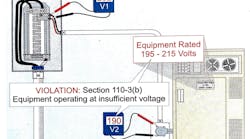Note: This article is based on the 1999 NEC.
Voltage Drop -- Part 1
The purpose of the National Electrical Code (NEC) is to help safeguard persons and property from electrical hazards. Although it does not generally consider voltage drop a safety issue, it contains six Fine Print Notes (FPNs) that recommend you size circuit conductors large enough to provide reasonable efficiency of the equipment. The NEC also has rules stipulating you must size conductors to accommodate voltage drop.
FPNs in the NEC are for informational purposes only. They're not enforceable by the inspection authority [90-5(c)]. However, Sec. 110-3(b) requires you to install equipment in accordance with the equipment instructions. Therefore, you must install electrical equipment so it operates within its voltage rating as specified by the manufacturer. (Fig. 1)
Due to voltage drop within the circuit conductors, the operating voltage at the electrical equipment will be less than the output voltage of the power supply. Inductive loads (such as motors or ballasts) operating at a voltage below their rating can overheat. Under-voltage for any sensitive electronic equipment (such as copy machines or computers) could cause equipment to power down or lock up. This can mean data loss, increased cost, and even possible equipment failure. Resistive loads (such as heaters or incandescent lighting) that operate at under-voltages will not provide the expected rated power output.
Voltage drop on the conductors can cause incandescent lighting to flicker when other appliances, office equipment, or heating and cooling systems cycle on. Although this might be annoying, it's not dangerous and doesn't violate the NEC.
NEC recommendations
The NEC contains six FPNs that explain how equipment can experience improved efficiency if you take conductor voltage drop into consideration. Let's take a look.
1. Branch circuits. This FPN recommends you size branch circuit conductors to prevent a maximum voltage drop of 3%. The maximum total voltage drop when combining both the branch circuit and feeder shouldn't exceed 5% [210-19(a) FPN No. 4]. (Fig. 2)
2. Feeders. Size feeder conductors to prevent a maximum voltage drop of 3%. The maximum to-tal drop for a combination of branch circuit and feeder should not exceed 5% [215-2(d) FPN No. 2].
Example: What's the minimum NEC recommended operating voltage for a 120V load connected to a 120/240V source (8-11)? (Fig. 3)
a. 120V
b. 115V
c. 114V
d. 116V
Answer: (c) 114V. The maximum conductor voltage drop recommended for the feeder and branch circuit is 5% of the voltage source; 120V x 5% = 6V. You determine the operating voltage at the load by subtracting the conductor's voltage drop from the voltage source, 120V - 6V drop = 114V.
3. Services. There's no recommended voltage drop for service conductors in the NEC. However, [230-31(c) FPN] reminds you to consider it.
4. Conductor ampacity. This FPN points out the ampacities listed in Table 310-16 do not take voltage drop into consideration [310-15 FPN No. 1].
5. Phase converters. Phase converters have their own recommendation that the voltage drop from the power supply to the phase converter should not exceed 3% [455-6(a) FPN].
6. Recreational vehicle parks. For recreational vehicles, the maximum voltage drop for branch circuit conductors should not exceed 3%, while the combined voltage drop of the branch circuit and feeder should not exceed 5% of the voltage source [210-19(a) FPN No. 4 and 551-73(d) FPN].
NEC requirements
The NEC also contains rules requiring you to increase circuit conductors in size to accommodate voltage drop. You can categorize these rules into three general groups:
Grounding conductors. Where you increase circuit conductors in size to compensate for voltage drop, you must also increase the equipment-grounding conductors in size [250-122(b)]. If you don't do this, the equipment-grounding conductor is not required to be larger than listed in Table 250-122.
Motion picture/television studios. Branch circuit conductors for 60V/120V systems used to reduce noise in audio/video production or other similar sensitive electronics for motion and television studios must not exceed 1.5%, and the combined voltage drop of the feeder and branch circuit conductors must not exceed 2.5% [530-71(d)]. FPN No. 1 to Sec. 530-72(b) reminds you to increase the size of the grounding conductor in accordance with Sec. 250-122(b).
Fire pumps. The operating voltage at the terminals of a fire pump controller must not be less than 15% of the voltage rating of the controller while the motor is starting (lock-rotor current).
In addition, the operating voltage at the terminals of the fire pump motor must not be less than 5% of the voltage rating of the motor when the motor is operating at 115% of its full-load current rating [695-7].
Next month, I'll give examples demonstrating how to calculate the voltage drop of the conductors by one of two methods: Ohm's law or the VD formula.
You can reach Mike Holt at (888) NEC Code [(888) 632-2633]; [email protected]; or www.mikeholt.com.







